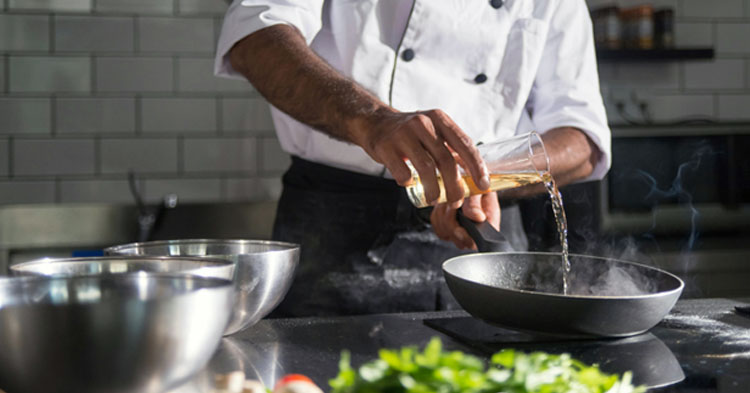Uncovering the Least and Most Competitive Types of Restaurants to Open in 2025
The restaurant trade is set to become a trillion-dollar industry in 2024. Along with those who enter the business for the joy of food and hospitality are plenty of entrepreneurs looking for a slice of that vast revenue. But with high set-up costs, average pre-tax profits of just 4% for full-service eateries and ongoing supply chain issues, foodies and entrepreneurs alike must strategize with care if their new restaurants are to break out of the red.
As the lockdown pivot to pick-ups, deliveries and subscriptions demonstrated, flexibility is a key asset in the hospitality industry. Even now, “small but quick-moving brands are now routinely outperforming larger, more entrenched players” on delivery apps, according to McKinsey & Company. Flexibility means adapting not just to consumer behavior but to local market trends. And there is no bolder way of doing that than finding a cuisine concept that’s underserved in your neighborhood — and heading to the kitchen.
To find out which restaurant cuisine types face the most and least competition around the U.S., OnDeck compared the density of different food business types in each state and large city to the national average.
What We Did
We identified 32 food business types (e.g., steakhouse, Korean, brunch, burgers, etc.) and collected the number of establishments in 502 major U.S. cities across all 50 states. Then, we calculated the amount of each business type per 100k population to find the density of each type in each location. Finally, we compared these densities to the national U.S. average to determine the most (highest above the national average density) and least competitive markets.
Key Findings
- At a national level, Steakhouses face the most direct competition. In seven states steakhouses face more competition than any other restaurant type.
- Across the U.S., the least competitive restaurant type to open in 2025 is Korean, which faces the least competition in 12 states.
- In New York City the most competitive type of restaurant to open in is French, and the least competitive is barbecue.
- In Los Angeles, sandwich joints face the least competition, while Korean restaurants face the most.
The Most Competitive Food Business Market by State
Steakhouses are overrepresented across much of the West, Midwest and South — facing the most competition in seven states, which is more than other cuisine. On a similar theme, barbeque restaurants dominate across six more South and West American states.
The development of these cuisines has become a self-perpetuating trend. The availability and affordability of beef and pork meat have resulted in local specialties, including barbecue and other cooking methods that have become synonymous with their origins — and now tourists and locals alike expect to find them here. We discovered that Montana has 5 times the national average of steakhouses per 100K population, which is the most competitive steakhouse market of any state.
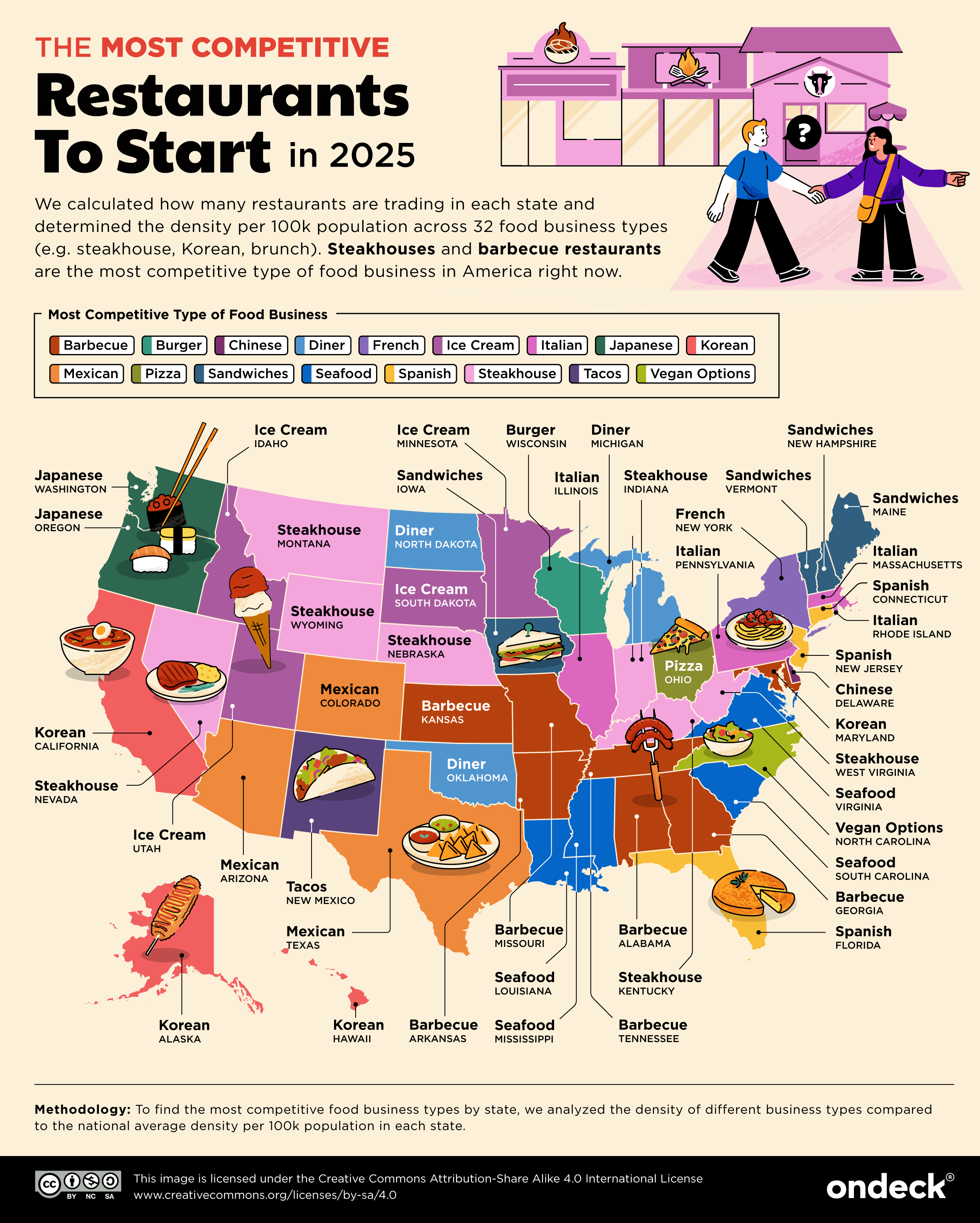
Cuisines tied to specific nationalities (Chinese, French, Italian, Japanese, Korean, Mexican and Spanish) are the most overrepresented in 18 states — 19 if you include tacos as a national category. These follow the heritage of their particular states to some degree. For example, three of the four states with the highest proportional representation of Italian restaurants are among the six with the densest Italian population (Massachusetts, Pennsylvania and Rhode Island).
The toughest state to open one particular restaurant type is Hawaii, where there are 19.6 Korean restaurants per 100,000 people. This is 24.5 times greater than the national rate of 0.8 Korean restaurants per 100,000 people.
The Least Competitive Food Business Market by State
There is a significant lack of Korean (12 states) and Spanish (nine states) restaurants across the country.
New York is the only state where French restaurants are the most overrepresented (above). Alaska and Connecticut are among the nine states with fewer French restaurants than the average number per 100K population, and the remaining seven are in the South, West or Midwest. With today’s diners seeking familiarity rather than risking their money on something new, the simple but considered cuisine of a French bistro or brasserie could be due for a comeback.
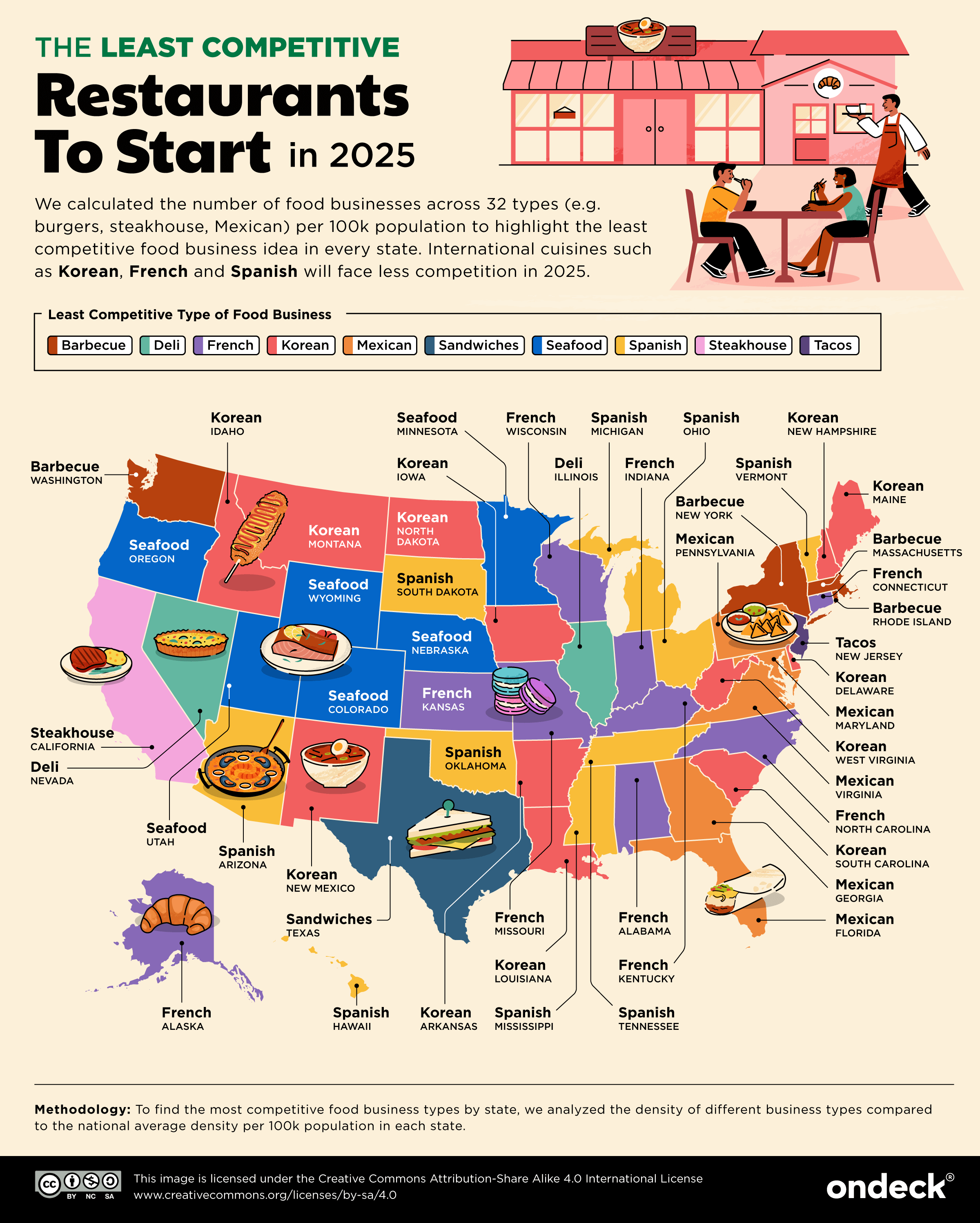
In California, it is the steakhouse that is most underrepresented: there are 60% fewer per head than the national average. America’s relationship with the steakhouse has become complex, with chain steakhouses appealing to the budget-conscious while urbanites flock to fancier joints for the “vibes” rather than the steaks. Health concerns have also impacted the popularity of red meat, which could explain the lack of steakhouses in health-conscious California.
It is also worth noting that researchers have found that California is currently the hardest place to start a restaurant due to a combination of factors, including the high cost of rent, food service permits and corporate tax.
The Most Competitive Food Business Market in Major U.S. Cities
On a citywide basis, barbecue restaurants exist at more than twice the national average density in Oklahoma City, Nashville and Memphis; likewise, there are double the average number of taco places per head in Boise, Austin and Santa Cruz.
French restaurants occur at more than double the national rate in San Francisco, Charleston and more than five times the national rate in New Orleans. French colonists founded the latter in 1718: “Our French connection brings a different flavor to our community,” says Alexandra Stafford, president of the Council of French Societies. “A different vocabulary, different traditions, different food and most importantly, a joie de vivre that other parts of America don’t have!”
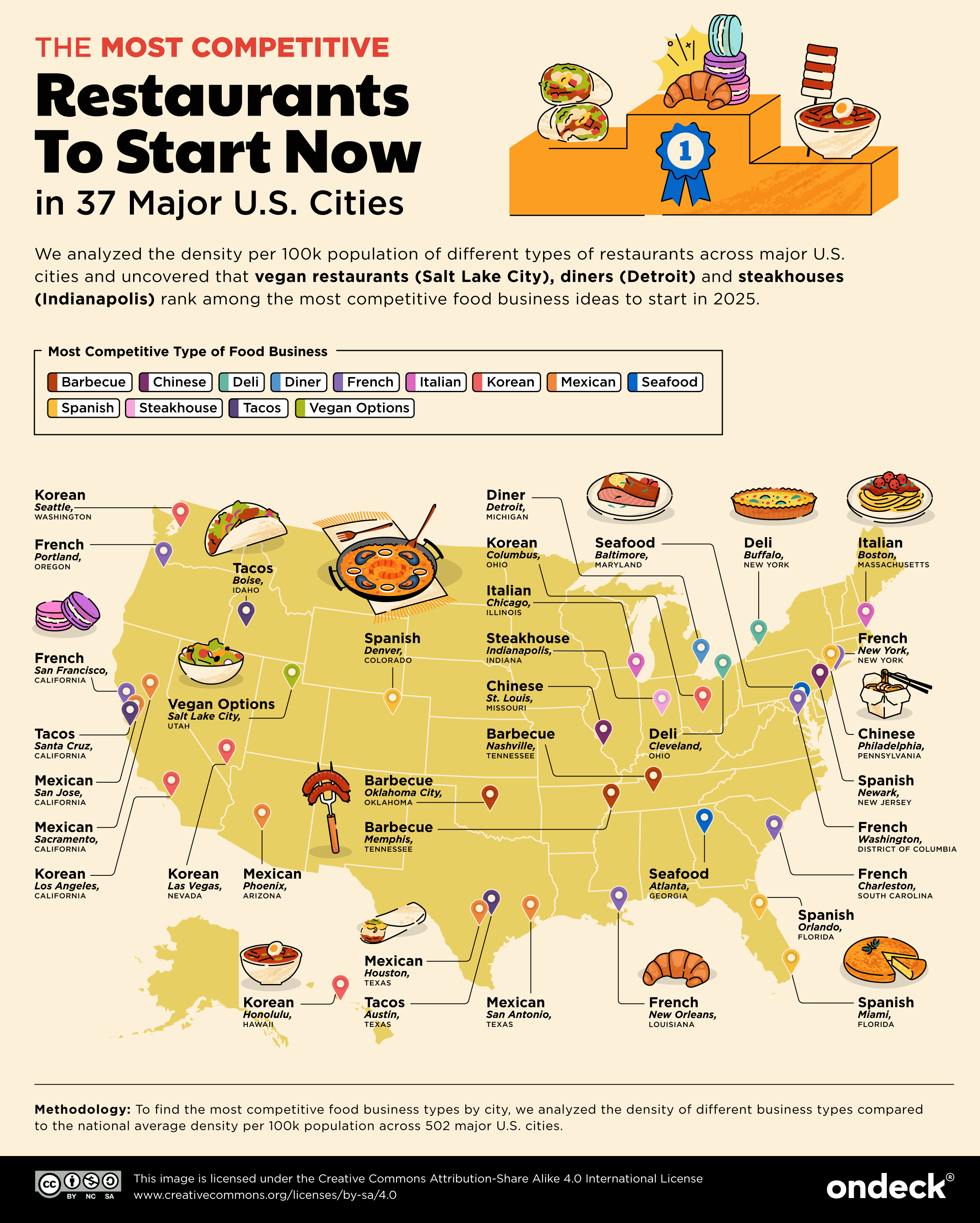
However, the most competitive market is for Korean food in Honolulu. There are 19.2 Korean restaurants per 100,000 people in the Hawaiian capital versus a national average of just 0.8.
Koreans have migrated to Hawaii for over 120 years, with 1,000 new arrivals yearly during the 1970s. In fact, the seeming abundance of Korean restaurants may be of mutual advantage: the ‘Koreatown’ neighborhood of Keeaumoku is a go-to place just because there are so many Korean joints, while local entrepreneurs are known to join forces and support each other.
The Least Competitive Food Business Market in Major U.S. Cities
There are just one-third of the burger joints per head in San Jose as there are across the country. Burger places are the least competitive cuisine type in the city, suggesting a gap in the market. The city recently lost its beloved Burger Pit, a restaurant that had served Silicon Valley for 70 years, when the property owner declined to renew the lease.
“We were before McDonald’s, before Burger King, everybody,” the aptly named proprietor Paul Berger told San Jose Spotlight. The company built a loyal following with good prices and personable service. “I’m selling Burger Pit T-shirts and coffee mugs (and) we ran out,” continues Berger. “We sold 288 of them in 10 days.”
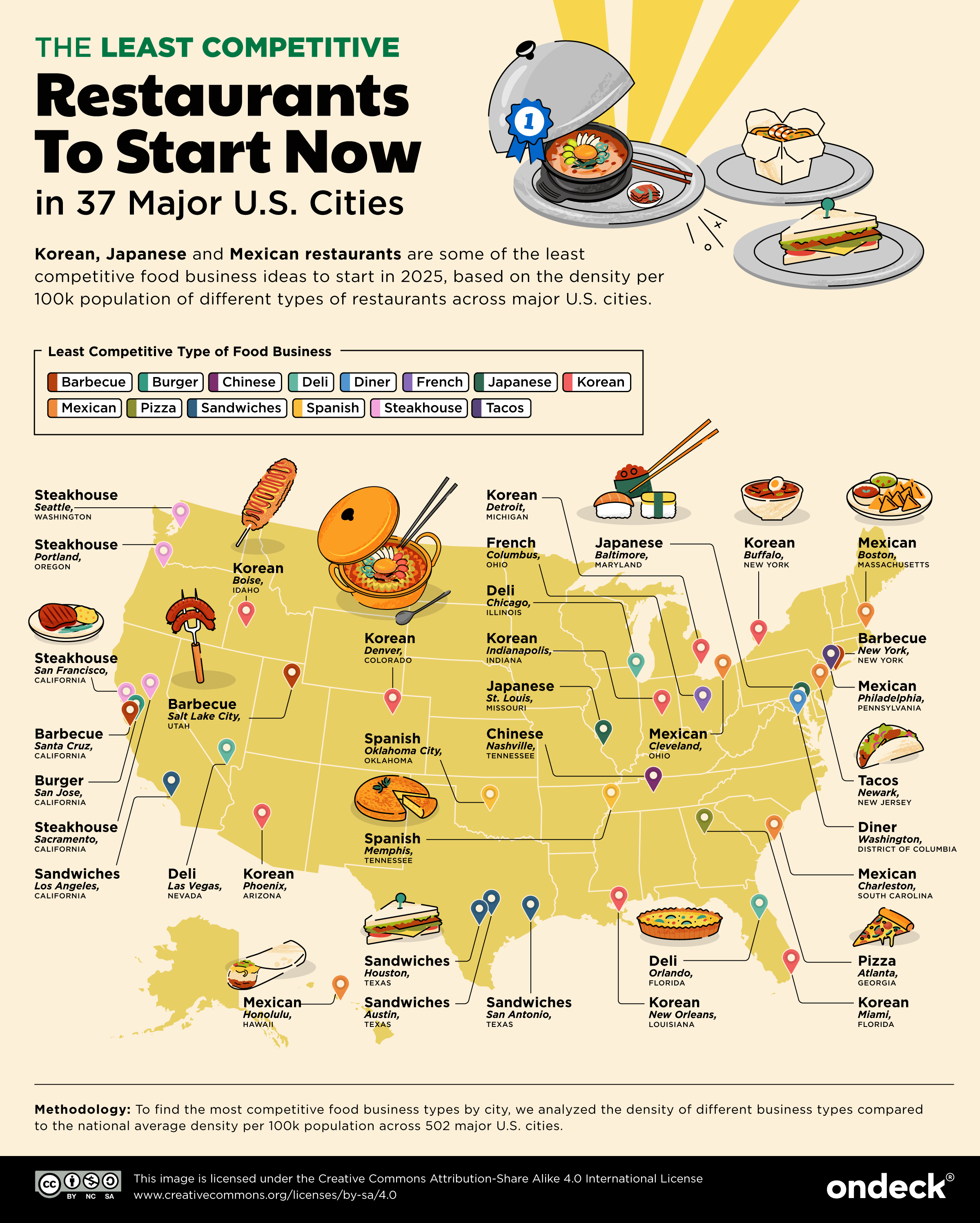
Meanwhile, there is a gap in the market for delis in Orlando and Chicago. At one point, the number of Jewish delis in Chicago was literally uncountable — not least because many small early-20th-century delis didn’t even have names.
The plight of the deli in Chicago and, indeed, across America may be partly due to rising costs. Deli customers expect high-quality ingredients in their sandwiches and low prices. It also became harder to compete with streamlined fast food joints that emerged — though newer delis have learned from the competition.
“As more modern management techniques and kitchen management techniques have been applied, it’s just another type of restaurant that you have to apply food cost management principles to,” says Chicago deli owner Aaron Steingold, “and as long as you keep your costs in line, they can be successful.”
A Course to Success
A restauranteur’s first recipe is not what arrives on the plate but everything around it. From choosing the location and the décor to hiring the right staff, everything must be balanced to encourage drop-ins, habitual users and a vibe that gets people talking — and reviewing — positively. Since it takes time and money to establish an eatery, the food entrepreneur needs not to react to trends but to pre-empt them. And the best way to do so may be to look around at what other restauranteurs are offering and see what’s missing.
Methodology
To find the most and least competitive food business types by state and city, we analyzed the density of different business types compared to the national average.
We started with a seed list of 32 food business types (e.g., steakhouse, Korean, brunch, burgers, etc.) and collected the number of these types of establishments in 502 major U.S. cities across all 50 states.
We then calculated the count of each business type per 100k population in each state and city. Comparing these densities to the national U.S. average allowed us to determine the most and least competitive markets:
- Most competitive market = Business type that’s highest above the national average density per 100k population.
- Least competitive market = Business type that’s most below the national average density per 100k population.
This data analysis was completed in July 2024.
DISCLAIMER: This content is for informational purposes only. OnDeck and its affiliates do not provide financial, legal, tax or accounting advice.
